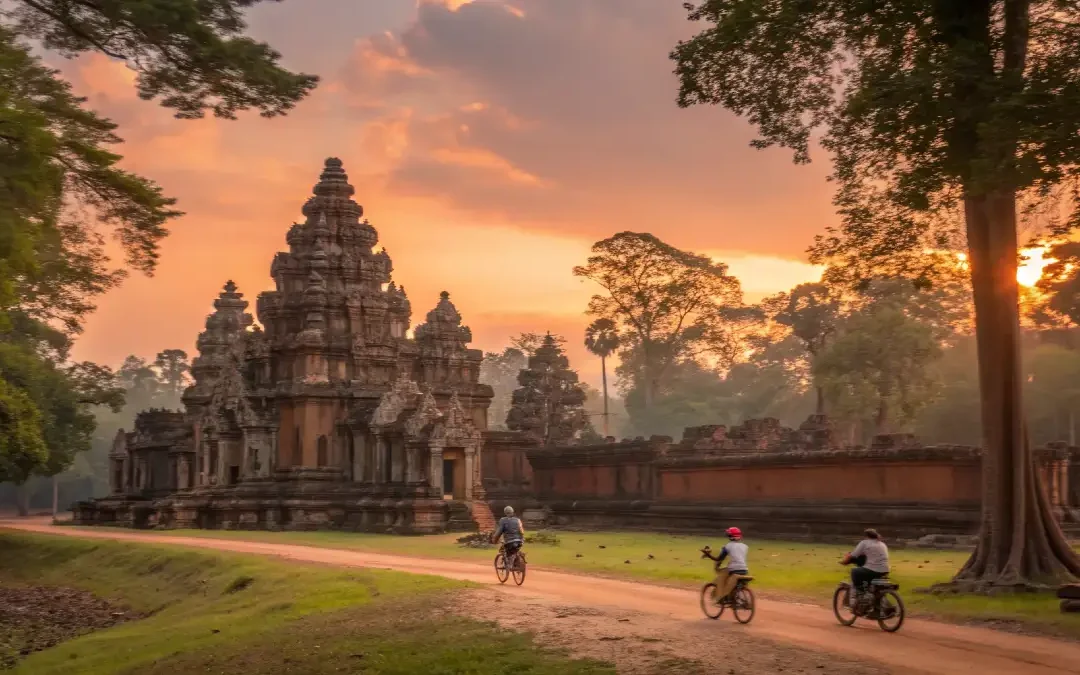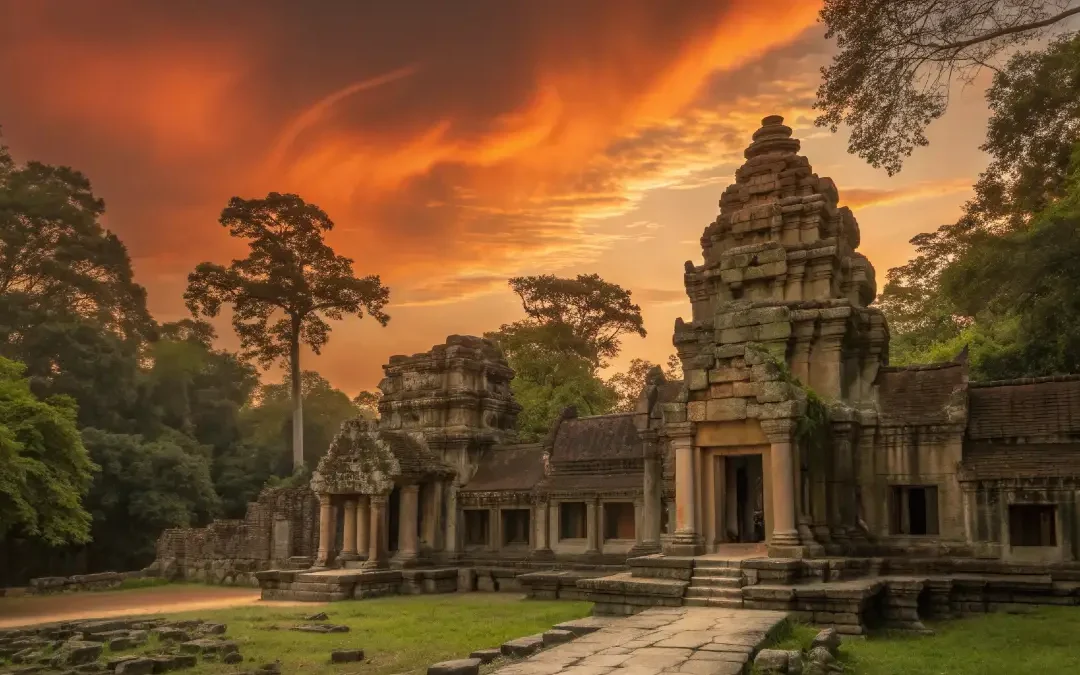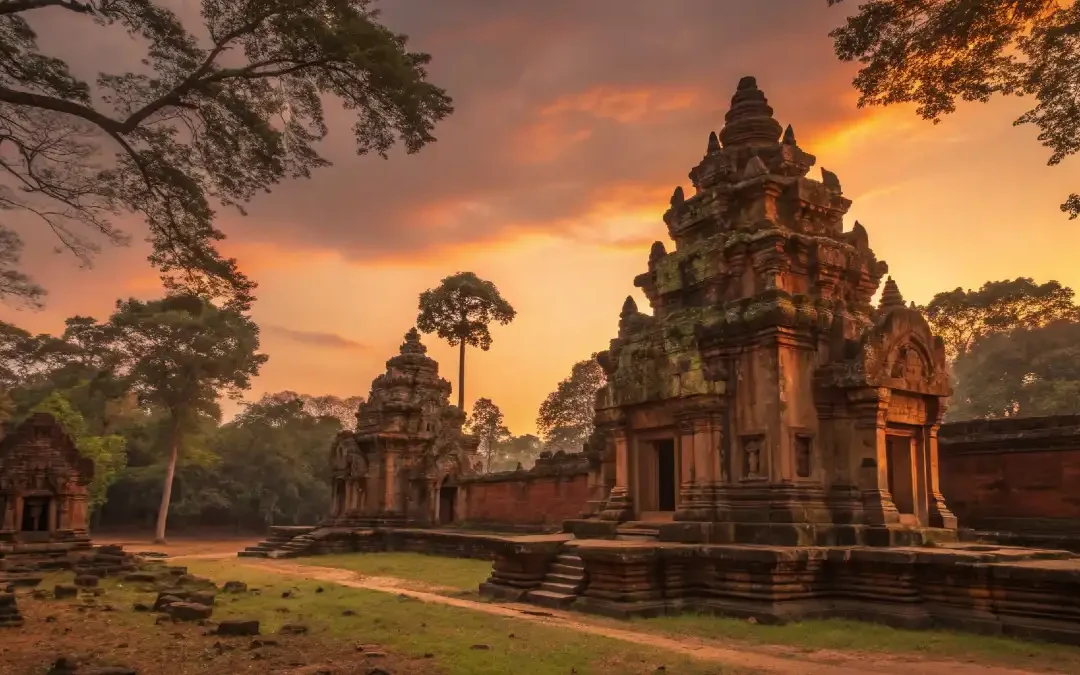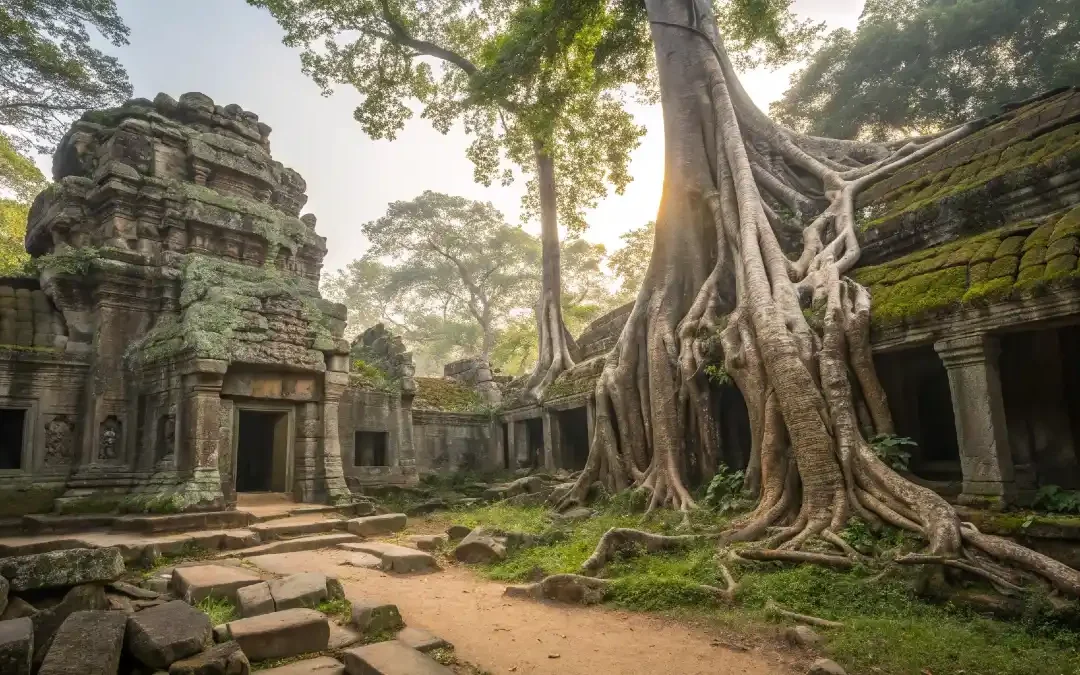Travel
Khmer Architecture: Angkor’s Symbols Decoded
The key takeaway: Angkor Wat’s grandeur lies in its symbolic representation of Hindu cosmology (Mount Meru) and its engineering marvels, blending religion, royalty, and advanced construction techniques. This offers insight into Khmer civilization’s spiritual depth and architectural ingenuity, preserving a living heritage that continues to captivate globally. Over 1,796 unique devatas and apsaras adorn the temple, each carved with individual details.
Are you overwhelmed by the intricate details of Khmer architecture, Angkor symbols, and sculptures during your visit? This guide deciphers the cosmic symbolism and mythological narratives etched into Angkor Wat’s walls—from the temple-mountain design mirroring Mount Meru (Hinduism’s sacred peak) to the celestial dancers (apsaras) adorning its corridors. Explore bas-reliefs spanning 1,000 m² depicting epics like the Churning of the Ocean of Milk, while guardian figures like Nāga serpents and Kala faces reveal spiritual and royal layers. Discover the ingenuity of Angkor’s construction, its UNESCO status, and how its fusion of Hindu and Buddhist elements fascinates the world.
- What defines the grandeur of khmer architecture?
- Angkor’s Temples: A Universe Carved in Stone
- The Great Stone Galleries: Narratives Of Gods And Kings
- Decoding the iconic symbols of angkor
- The Genius Of Khmer Builders And Artisans
- The enduring significance of Angkor’s art
What defines the grandeur of khmer architecture?
The golden age of angkor
Khmer architecture reached its peak between the 9th and 15th centuries, with Angkor Wat standing as its crowning achievement. Built by King Suryavarman II in the early 12th century, this temple complex symbolizes the zenith of imperial ambition and spiritual devotion. Originally dedicated to Hindu god Vishnu, it later transitioned into a Buddhist site, reflecting the region’s evolving religious landscape. The term “Angkor” itself denotes the empire’s ancient capital, where temples were not mere structures but manifestations of divine authority.
Angkor Wat’s alignment with celestial events, such as the spring equinox sunrise, underscores the sophistication of its design. Constructed using millions of sandstone blocks transported from Mount Kulen, its scale and precision reveal advanced engineering. The temple’s western orientation, rare for Khmer structures, hints at its dual role as a funerary monument and a cosmic microcosm.
Core principles: Religion, royalty, and representation
Khmer architecture intertwines three pillars: religious symbolism, royal power, and cosmological representation. Temples functioned as cosmic maps, with their central towers embodying Mount Meru, the mythical abode of gods. Kings legitimized their rule by commissioning these structures, blending divine and earthly authority. Over time, Hindu iconography gave way to Buddhist motifs, yet both traditions left indelible marks on the temples’ narratives.
- Sandstone as the primary building material, quarried from Mount Kulen.
- Symmetrical layouts with concentric enclosures mirroring cosmic order.
- Bas-reliefs depicting Hindu epics like the Mahabharata and Ramayana.
- Temple-mountain designs symbolizing Mount Meru’s five peaks.
- Water features like moats and barays reflecting spiritual and practical functions.
The intricate bas-reliefs adorning Angkor Wat narrate myths such as the Churning of the Ocean of Milk, blending artistic mastery with spiritual storytelling. Over 1,796 devatas and apsaras carved into walls highlight the fusion of decorative art and protective symbolism. These elements collectively anchor Khmer architecture in a legacy where every stone serves both aesthetic and metaphysical purposes.
Angkor’s Temples: A Universe Carved in Stone
The Temple-Mountain and the Sacred Mount Meru
Angkor Wat embodies Mount Meru, the cosmic axis in Hindu and Buddhist traditions. Its five central towers form a quincunx, echoing the mountain’s peaks. This design reflects a cosmic hierarchy, merging religion with royal authority. The temple’s layered structure symbolized a pilgrimage from earth to divinity, positioning the Khmer king as a divine mediator. By replicating Mount Meru, the temple anchored the kingdom in universal order, transforming stone into a political and spiritual statement.
The quincunx wasn’t mere decoration—it reinforced the king’s divine mandate. Each level of the temple mirrored mythological tiers, where gods and rulers coexisted. This alignment validated the ruler’s cosmic role, placing his realm at the center of existence. Rituals like the hieros gamos, performed at the temple’s apex, symbolized the union of celestial and terrestrial forces, ensuring the kingdom’s prosperity. The Garuda, Vishnu’s mount, carved into the temple, further emphasized the king’s celestial endorsement.
Water as a Cosmic Ocean: The Role of Moats and Barays
Angkor Wat’s moats and barays (reservoirs) symbolize the cosmic ocean encircling Mount Meru. For pilgrims, crossing the moat marked a transition from the ordinary to the sacred. Beyond aesthetics, these water features channeled irrigation, prevented erosion, and embodied creation’s chaotic origins, tamed by divine order. Their presence linked the temple to the Churning of the Ocean of Milk, a myth depicted in bas-reliefs, merging practicality with spiritual symbolism. Water’s duality—life-giving yet chaotic—mirrored the cosmic struggle between deities and demons in the myth, reinforcing the temple’s role as a microcosm of this eternal balance.
A Journey from West to East: The Unique Orientation of Angkor Wat
Angkor Wat’s westward orientation breaks Khmer temple conventions. Most faced east, symbolizing renewal; here, the west connects to Vishnu, god of preservation, or suggests a funerary role for King Suryavarman II. The counterclockwise flow of bas-reliefs—a Hindu funerary practice—supports this theory. During equinoxes, the sun aligns with the central tower, blending astronomy with spirituality. This alignment emphasized the temple’s cosmic axis (axis mundi), linking heaven, earth, and the underworld. The westward gaze may have honored Vishnu’s dominion over time, with each equinox sunrise reaffirming the king’s role in sustaining cosmic balance. The temple’s orientation also reflects Vishnu’s association with the setting sun, a metaphor for cyclical rebirth and the king’s eternal rule.
The Great Stone Galleries: Narratives Of Gods And Kings
An Introduction To The Art Of Bas-Reliefs
Angkor Wat’s bas-reliefs stretch across nearly 1,000 m² of temple walls, telling stories etched in stone. These shallow carvings are more than decoration; they are visual chronicles of myth and history. Unlike free-standing statues, bas-reliefs allow artists to depict sprawling narratives in a single frame. Their scale is staggering—some panels span 50 meters, inviting viewers to lose themselves in divine battles and royal processions. This technique, blending Hindu and Buddhist elements, reflects the Khmer Empire’s mastery of turning rock into a living canvas.
Epic Tales From Hindu Mythology
Among Angkor’s most striking panels is the “Churning of the Ocean of Milk,” a 50-meter-long bas-relief depicting a cosmic struggle. Here’s how it unfolds:
- The Churning of the Ocean of Milk: 88 Devas and 92 Asuras pull the serpent Vasuki coiled around Mount Mandara to extract the elixir of immortality. Vishnu’s central role as mediator underscores his role as preserver of the universe.
- The Battle of Kurukshetra: From the Mahabharata, armies clash in a dynamic composition that captures the chaos of war. Archers ride chariots; elephants trample foot soldiers, echoing the epic’s themes of duty and moral conflict.
- The Battle of Lanka: Rama’s army storms the demon king Ravana’s fortress, emphasizing heroism and divine justice.
- Heavens and Hells: A stark contrast between 37 celestial realms and 32 infernal realms, illustrating karmic consequences, with sinners shown in graphic detail.
Each figure’s posture and expression reveal emotional depth. Vishnu’s commanding presence in the “Churning” scene symbolizes cosmic balance, while the chaotic troop formations in the Battle of Lanka mirror real Khmer military tactics. These carvings were not just art—they were lessons in dharma, blending Hindu cosmology with earthly ethics.
The Historical Procession Of Suryavarman II
One gallery stands apart: a 94-meter-long relief showing King Suryavarman II’s procession. Unlike mythological scenes, this panel anchors Angkor Wat in tangible history. The king, depicted larger than other figures, rides an elephant flanked by 15 parasols—a visual declaration of his divine authority. Behind him, brahmins carry sacred fire, while musicians play conches and gongs. This procession isn’t just ceremonial; it’s a political statement. Zhou Daguan’s 13th-century accounts confirm such displays were real, linking the carvings to living tradition. The blend of Hindu cosmic order and Khmer military might here cements the temple’s role as both a spiritual and royal monument.
Details like the elephants’ jeweled headdresses and the inclusion of Siam mercenaries in the relief reveal the empire’s cultural diversity. These subtle elements highlight how Angkor Wat’s stones preserve not just myths, but the pulse of a civilization at its peak.
Decoding the iconic symbols of angkor
Apsaras and devatas: The celestial dancers and deities
Over 1,700 apsaras and devatas adorn Angkor Wat, each carved with unique expressions, headdresses, and poses. Apsaras, often depicted mid-dance, embody celestial movement and grace, while devatas stand still, exuding serene divinity. Both serve as spiritual guardians and artistic marvels. Their intricate details—delicate jewelry, flowing garments, and symbolic gestures—reflect the Khmer Empire’s mastery of stone carving. These figures aren’t merely decorative; they symbolize the bridge between the earthly and the divine, guiding souls toward enlightenment.
What makes these carvings remarkable is their individuality. No two apsaras share the same coiffure or posture. Some hold lotus blossoms, others gaze skyward or clasp their hands in mudras. Historically, the Khmers viewed all these figures as “apsaras,” blending Hindu and Buddhist elements. Their presence transforms temples into living narratives of cosmic harmony, where art meets spiritual storytelling.
Mythical guardians and divine symbols
| Symbol | Description and Meaning | Common Location |
|---|---|---|
| Nāga | Multi-headed serpents symbolizing water, fertility, and cosmic order. They guard sacred spaces, linking humans to the divine. | Flanking causeway entrances; depicted in the Churning of the Ocean of Milk. |
| Garuda | Vishnu’s eagle mount, representing solar power and the sky. Often shown battling Nāgas to signify cosmic balance. | Carved as structural supports or in combat scenes with Nāgas. |
| Kala | A monstrous face devouring time itself. Its grimace wards off evil, protecting temple thresholds. | Adorning doorways and windows as a protective emblem. |
| Singha (Lion) | Guardian lions embodying strength and regal power, shielding sacred grounds from harm. | Flanking temple entrances in pairs. |
These guardians aren’t just ornamental; they’re steeped in symbolism. The Nāga’s undulating bodies evoke life-giving rivers, while Garuda’s fierce clashes with serpents mirror the struggle between order and chaos. Kala’s visage, suspended above doorways, reminds visitors that time consumes all—yet temples endure as timeless sanctuaries. Even the Singha’s paired stance reflects balance, a core tenet of Buddhist philosophy.
Why does this matter? Each symbol weaves Hindu and Buddhist ideologies into stone. The Churning of the Ocean of Milk bas-reliefs, for instance, depict gods and demons working together—a metaphor for collective spiritual pursuit. Such artistry reveals how Khmer rulers blended religion with royal authority, turning temples into metaphysical maps of the universe. To miss these details is to overlook Angkor’s deeper narrative: a civilization that carved its soul into every pillar and lintel.
The Genius Of Khmer Builders And Artisans
Sourcing And Transporting The Sandstone
The construction of Angkor Wat relied on sandstone quarried from the Kulen Mountains, located roughly 40 km northeast of the temple. Extracting these stones required meticulous planning: artisans used wooden wedges soaked in water to split the sandstone—a technique still observed in traditional Cambodian stonework. This method, combined with hand-carved channels to guide fractures, minimized waste while maximizing usable blocks. Transporting 5–10 million sandstone blocks, some weighing over 1.5 tonnes, required advanced logistics. This achievement underscores the cultural significance of Khmer engineering, blending practicality with spiritual purpose.
Historians believe a network of canals was used to float stones downstream on rafts during monsoon seasons. Seasonal rains likely aided navigation, with channels dug to connect quarries to the Siem Reap River. Mobilizing 300,000 workers and 6,000 elephants highlights how deeply religious devotion and royal ambition were interwoven in Khmer society. Evidence suggests stones were marked with symbols for identification, ensuring they reached their intended location without confusion. These efforts transformed a distant quarry into the foundation of a sacred monument without modern tools.
Masterful Construction And Carving Techniques
Khmer builders achieved architectural marvels through precision. Sandstone blocks were cut to fit seamlessly without mortar, creating nearly invisible joints. Walls were assembled by aligning stones, with some polished against each other for adhesion. This method reflects the artistic techniques that ensured structural and symbolic harmony. Corbelling, a signature Khmer innovation, allowed them to create vaulted ceilings by layering stones in a step-like pattern—distributing weight evenly without keystone support.
- Precision stone cutting: Blocks were interlocked without binding agents. Chisels made from harder stones or bronze likely aided in carving details.
- Corbelling: Arches used overlapping stone layers for stability, differing from Roman arches.
- Post-assembly carving: Bas-reliefs were carved directly onto walls, adapting designs to architectural curves for cohesive storytelling.
These methods highlight the cultural significance of Khmer architecture. Post-assembly carving allowed artisans to align mythological narratives like the Barattage de la Mer de Lait with sacred geometry. For example, the Battle of Lanka scene in Angkor Wat’s western gallery wraps around corners, maintaining visual continuity. Such practices ensured Angkor Wat endured centuries of environmental and human impact.
Every stone at Angkor Wat reflects a civilization balancing engineering and artistry. The Khmer Empire’s legacy lies in the ingenuity of its builders—proven through corbelled arches, mortarless walls, and carvings that merge technical mastery with spiritual symbolism. These techniques weren’t just functional; they mirrored cosmological beliefs, turning temples into microcosms of the universe itself.
The enduring significance of Angkor’s art
The fusion of hindu and buddhist elements
Angkor Wat’s evolution from a hindu temple to a buddhist site reflects the fusion of hindu and buddhist elements in its design. Initially dedicated to Vishnu, its layout mirrors the cosmic mountain Meru, with central towers symbolizing peaks and surrounding moats representing oceans. This sacred geometry aligns with celestial events, like equinox sunlight illuminating its main tower.
Bas-reliefs across its galleries depict hindu epics—the Ramayana’s Lanka battle and the Mahabharata’s Kurukshetra war—while later buddhist additions introduced serene Buddha figures. The eastern gallery’s Churning of the Ocean of Milk scene, showing dozens of asuras and devas coiling the serpent Vasuki, symbolizes the triumph of order over chaos, a theme resonating in both traditions. The temple’s transition is visible in sculptures: hindu devatas and apsaras coexist with buddhist iconography, illustrating a harmonious blend of spiritual traditions over centuries.
A symbol of national pride and world heritage
Angkor Wat’s towering spires and intricate khmer architecture angkor symbols sculptures remain central to Cambodia’s identity. Featured on the national flag since 1953, it embodies resilience and cultural continuity. Its 1992 UNESCO designation underscores its global legacy as a living heritage site, where rituals and local traditions persist alongside ancient stones.
Despite challenges like tourism-driven erosion and environmental threats, Angkor’s art endures. Communities near the site maintain ancestral practices, integrating temple worship with daily life. Local residents rely on traditional agriculture and medicinal plants tied to temple rituals. The temple’s bas-reliefs and devatas aren’t relics but symbols of a civilization’s timeless dialogue between earth and divinity, inviting the world to explore its layers of meaning. International efforts, like the ICC-Angkor, balance preservation with modern pressures, ensuring Angkor’s legacy for future generations.
Khmer architecture’s grandeur lies in its divine symbolism, artistic mastery, and Angkor Wat’s testament to a civilization blending Hindu and Buddhist influences into temples and carvings. A UNESCO site, it embodies Cambodia’s enduring cultural pride, where history and ingenuity resonate as a timeless legacy.






0 Comments